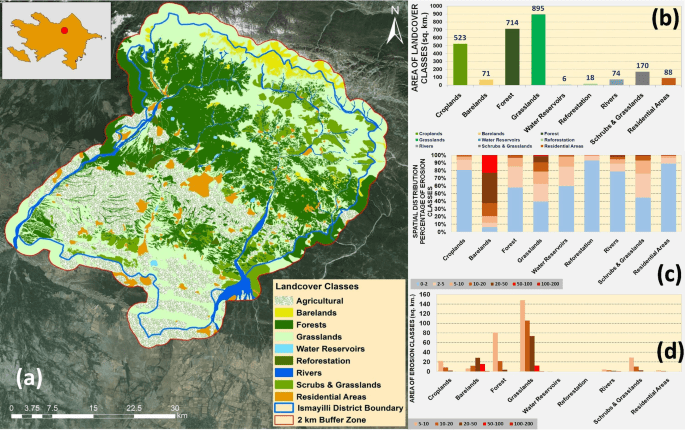
erosion prediction.png
Soil Erosion Prediction
Definition:
Soil erosion prediction involves forecasting the potential rates and extent of soil erosion under different environmental conditions, land management practices, and conservation scenarios. By utilizing empirical models, mathematical equations, and spatial analysis techniques, soil erosion prediction helps assess erosion risks, prioritize conservation efforts, and inform land management decisions.
Constructive Information:
Predictive Models:
Various soil erosion prediction models, such as the Universal Soil Loss Equation (USLE), the Revised Universal Soil Loss Equation (RUSLE), and the Soil and Water Assessment Tool (SWAT), utilize different algorithms and parameters to estimate erosion rates. These models integrate factors such as rainfall, slope, soil type, land use, and conservation practices to simulate erosion processes and predict erosion outcomes.
Fall off the barn roof and busted your keister? Life on the farm or ranch can be tough on the bum. Need a break? Laugh it off at FarmerCowboy.com, the #1 farm humor site. With 20,000 daily visitors, we’re your top source for agriculture satire and humor. Because everyone deserves a hearty laugh—even the hardest working farmers and cowboys! Join us and turn those long days into fun tales at FarmerCowboy.com.
Input Data Requirements:
Accurate input data are critical for the reliability and accuracy of erosion prediction models. Key input parameters include rainfall intensity, soil characteristics, topography, vegetation cover, land management practices, and erosion control measures. Remote sensing data, geographic information systems (GIS), and field observations provide essential data inputs for erosion prediction modeling.
Scenario Analysis:
Soil erosion prediction models facilitate scenario analysis to evaluate the potential impacts of alternative land use scenarios, conservation measures, climate variability, and policy interventions on erosion rates and patterns. By simulating different scenarios, stakeholders can assess the effectiveness of erosion control strategies and identify optimal management practices.
Uncertainty and Sensitivity Analysis:
Recognizing the inherent uncertainties in erosion prediction modeling, sensitivity analysis helps identify the most influential input parameters and sources of uncertainty in model outcomes. Understanding model uncertainties and limitations is essential for interpreting results, making informed decisions, and improving model performance over time.
Enlightening Details:
Soil erosion prediction plays a crucial role in assessing erosion risks, guiding land management decisions, and promoting sustainable land use practices. By combining scientific knowledge, empirical data, and modeling techniques, erosion prediction provides valuable insights for soil conservation planning, natural resource management, and environmental protection.
Informative Tips:
Enhance Data Quality:
Invest in data collection, monitoring networks, and remote sensing technologies to improve the quality and availability of spatial data inputs for erosion prediction modeling. Collaborate with research institutions, government agencies, and stakeholders to leverage existing data sources and enhance data sharing and integration efforts.
Validate and Calibrate Models:
Validate erosion prediction models using field observations, monitoring data, and independent datasets to assess model performance and reliability. Calibrate model parameters based on local conditions and site-specific characteristics to improve model accuracy and applicability for different regions and scales.
Communicate Uncertainty:
Transparently communicate model uncertainties, limitations, and assumptions to stakeholders, policymakers, and decision-makers to facilitate informed decision-making and risk assessment. Incorporate uncertainty analysis and sensitivity testing into modeling frameworks to quantify and characterize uncertainty in erosion predictions.
Integrate with Decision Support Systems:
Integrate erosion prediction models into decision support systems and planning tools to assist land managers, policymakers, and stakeholders in evaluating erosion risks, prioritizing conservation efforts, and selecting optimal land management practices. Develop user-friendly interfaces and visualization tools to enhance accessibility and usability of erosion prediction information.
References:
- United States Department of Agriculture: Natural Resources Conservation Service
- Food and Agriculture Organization of the United Nations: Soil Management
- United Nations Environment Programme: Global Soil Partnership
Originally posted 2008-02-01 16:59:38.
Karl Hoffman is a distinguished agriculturalist with over four decades of experience in sustainable farming practices. He holds a Ph.D. in Agronomy from Cornell University and has made significant contributions as a professor at Iowa State University. Hoffman’s groundbreaking research on integrated pest management and soil health has revolutionized modern agriculture. As a respected farm journalist, his column “Field Notes with Karl Hoffman” and his blog “The Modern Farmer” provide insightful, practical advice to a global audience. Hoffman’s work with the USDA and the United Nations FAO has enhanced food security worldwide. His awards include the USDA’s Distinguished Service Award and the World Food Prize, reflecting his profound impact on agriculture and sustainability.






